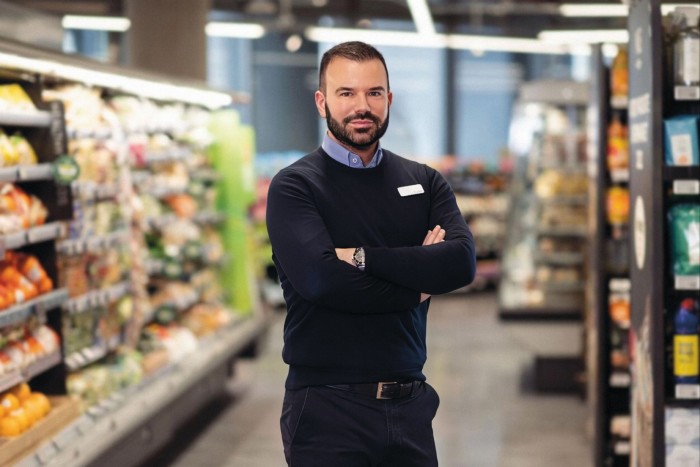Unlock the Editor’s Digest for free
Roula Khalaf, Editor of the FT, selects her favourite stories in this weekly newsletter.
One of the main architects of Marks and Spencer’s turnaround has credited its efforts to break the “vicious circle” of sticking with ageing customers for helping to revive the UK high street stalwart’s fortunes.
Chair Archie Norman told the Financial Times that the department store and grocery chain had previously focused too much on its older clientele and not enough on shoppers of all ages who want to look stylish.
“Because the customer base is ageing, we thought we should aim for ageing customers. The M&S core customer was seen as someone who no longer wanted to look stylish,” he said of the time when he was appointed in 2017. Now, the retailer understood that “you’d probably quite like to look like you did when you were 35 or 40”.
Gone from most stores are acres of drab clothes with confusing layouts. Instead, M&S has brought in upmarket fashionable brands such as Jaeger, which it bought out of administration in 2021, and begun selling others including Hobbs and Sweaty Betty on its website. Celebrities including Sienna Miller have been enlisted to front its fashion campaigns and it has embraced advertising on Instagram and TikTok.

For investors, the group is also back in fashion. The 139-year-old company, which has been promising shareholders and customers a revival for two decades, returned to the FTSE 100 after a four-year absence this year and announced this week that it would pay a dividend for the first time since before the pandemic.
M&S shares have more than doubled in the past 12 months, including the 9 per cent boost they received on Wednesday when the group reported a surge in first-half pre-tax profit, which jumped 56.2 per cent to £326mn.
Shareholders and analysts said that the retailer had turned a corner under Norman’s leadership.
Ian Lance, a fund manager at M&S shareholder Temple Bar Investment Trust, said the latest results “demonstrate that the strategy to reshape M&S is starting to deliver”.
“Phase one of this turnaround was about fixing the obvious strategic deficiencies within the business,” he said. “It feels like we are now moving on to phase two which is where the competitive advantage of the reshaped business starts to deliver real growth.”
But several cautioned that it still has a lot of market share to gain in food and clothing as well as remaining legacy systems to fix.
“Still in the M&S supply chain you have too many suppliers and a lack of smoothness from product leaving the factory through to reaching the store, so lots to do on that front,” said Clive Black at Shore Capital, adding that some stores still needed to be closed and others modernised.
Norman, a restructuring specialist and former MP, said his arrival followed “25 years of drift” at M&S, where the company had become notoriously slow moving.
M&S is now less sentimental about closing stores, having shut 86 outlets since 2017. The group has 244 full department stores selling clothes, food and homeware, with another 319 M&S-owned food stores and 461 franchise food stores.
Norman said there were more closures to come, with M&S saying this week that just over 90 stores are expected to go.
The 69-year-old acknowledged that the group had work to do on simplifying its supply chain, saying that it was “30 per cent of the way through” the work he wants to do.
A relatively new leadership team is also still becoming settled, he said. Former chief executive Steve Rowe stepped down last year and was succeeded by Stuart Machin, who oversaw the group’s food business. “Of our leadership team, 70 per cent of the top 15 [people], but also 70 per cent of the top 200 are now new to the business,” Norman said.

M&S has benefited from the collapse of several key high-street competitors in recent years — department store Debenhams and retail group Arcadia, which owned the Topshop, Burton, Evans and Wallis brands.
“I don’t expect a lot more capacity withdrawal, but you’re not seeing capacity increase either,” Norman said.
Store closures and a pullback from its international ambitions have freed up investment for its digital operation.
Online clothing sales have improved. “Our share of our sales online has gone from 17 per cent to around 30 per cent. We think that probably needs to go to 45,” he added. “We’ve not got open road but there’s a lot of space ahead.”

“There is lots of room for them to gain market share in clothing, and in food,” said Black at Shore Capital.
One key battleground is food. M&S’s latest profits were boosted by the performance of its upmarket grocery and food-to-go stores, which compete with the likes of Waitrose, and it has ambitions to increase its market share further.
Norman remains bullish on the prospects for Ocado Retail, the online supermarket it jointly owns. Although the partnership with Ocado is yet to be profitable — suffering a first-half operating loss of £23.4mn — M&S believes it will move into the black, albeit it in three years.
“Ocado, whatever you think of it, is going to grow,” he said.











